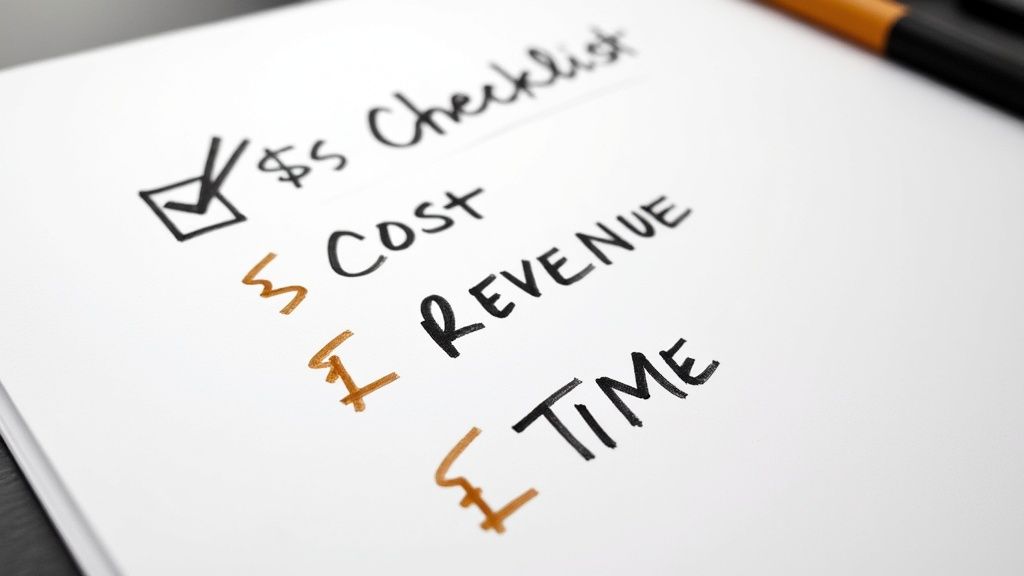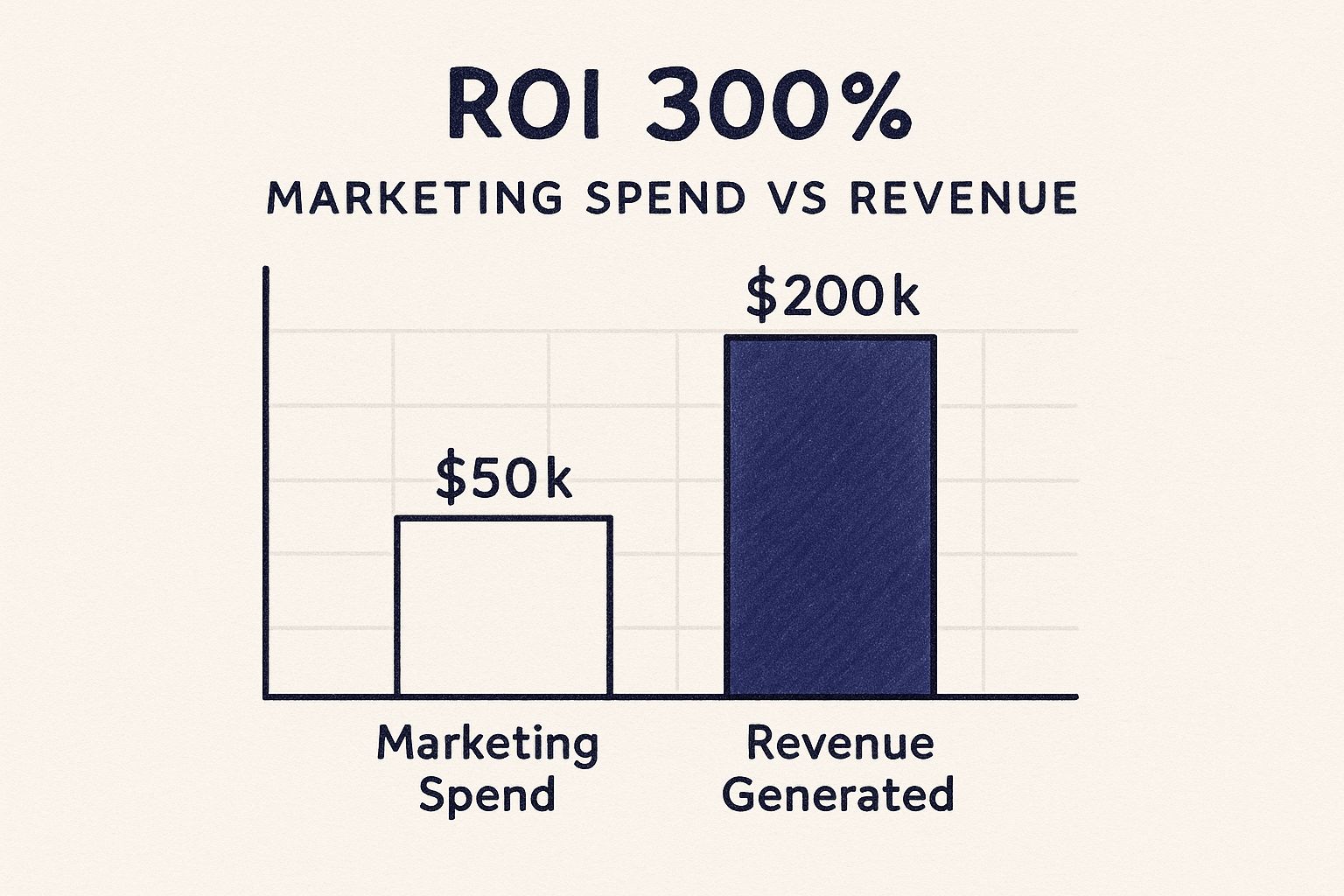
Mastering Business Lead Generation: Strategies for 2025 Success
Master business lead generation for 2025 success. Discover strategies, digital channels, and optimization tactics for quality leads.

To figure out your marketing ROI, the simplest way is to use this formula: (Sales Growth – Marketing Cost) / Marketing Cost.
This quick calculation tells you exactly how much you got back for every dollar you put in. Once you have this number, you can start making smarter decisions and confidently defend your marketing budget.

Calculating your return on investment doesn't need to be a complex process. The formula itself is straightforward, but the real trick is getting the inputs—'Sales Growth' and 'Marketing Cost'—right. Nail these, and you'll have an ROI figure you can trust.
Let's break down what goes into each part of the equation. Getting this right will give you the confidence to have clear, data-backed conversations about how your campaigns are performing. And if you're focused on guaranteed results, it might be worth looking into how a https://www.brandbooster.ai/blog/performance-based-marketing-agency-zpoua can tie their success directly to yours.
Your 'Marketing Cost' isn't just what you spend on ads. To get a true picture, you have to tally up every expense that went into a campaign or marketing push over a certain period.
Here’s a quick checklist of what to include:
Now for the other side: figuring out how much sales growth came directly from your marketing. One of the most reliable ways to do this is by looking at gross profit.
Let's walk through an example. Say you run a campaign that brings in $80,000 in new revenue. The cost of the goods you sold (COGS) to generate that revenue was $40,000, leaving you with a gross profit of $40,000. If you spent $10,000 on the marketing campaign, your ROI is a healthy 300%. That means for every $1 you spent, you got $4 back in gross profit.
The most important thing here is to isolate the lift in sales your marketing created. You can't just look at total revenue. You have to subtract your baseline sales (what you would have made anyway) from the total sales you saw during the campaign.
If you're looking for more examples, check out a comprehensive guide on how to calculate marketing ROI.

The old saying "garbage in, garbage out" is especially true for marketing ROI. Your final number is only as reliable as the data you feed into the formula. You need a complete picture of every dollar spent and every sale earned from your marketing. This means digging deeper than the obvious numbers. Many marketers only look at ad spend, which leads to an inflated ROI that doesn’t reflect reality.
First, you need to account for all of your marketing costs. If you miss an expense category, your results will be skewed. To get the full picture, make sure you're tracking these key costs:
Knowing what you spent is only half the battle. You also have to know which sales came directly from your marketing efforts. You need a clear, traceable line from a campaign touchpoint to a customer's purchase.
This is where proper tracking comes in, and UTM parameters are a marketer's best friend. These are simple tags you add to your URLs that tell your analytics platform where a visitor came from. For instance, a UTM tag can show you if someone clicked from a specific Facebook ad, an email newsletter, or a Google search result. This detail is crucial for attributing revenue to the right campaign.
A good content management system is also a huge help here. If you want to dive deeper, you can learn more about the top CMS features that make this kind of robust tracking possible.
You can't apply a single ROI formula across all your marketing efforts and expect a clear picture. The way you measure a paid search campaign is different from how you'd track a long-term content strategy. To know what’s working, you have to get specific.
Calculating ROI for a Google Ads campaign is often direct. You can connect ad spend to clicks and then to sales. But for a blog post, attributing revenue is a much longer game, often involving tracking assisted conversions over several months. Your content management system can be a huge help here, which you can read more about in our guide to the relationship between SEO and CMS.
Different channels have different performance expectations. A 5:1 revenue-to-spend ratio (500% ROI) is a great target for many campaigns, but some channels can blow that number out of the water.
This infographic shows how a marketing investment directly generates revenue.

As you can see, a $50k investment leading to $200k in revenue works out to a 300% ROI—a solid win that clearly justifies the spend.
Some channels are in a league of their own. For instance, email marketing can deliver an incredible 3,600% ROI on average. SEO isn't far behind, often pulling in a 2,200% return. Marketers who track these channel-specific returns are 1.6 times more likely to get their budget requests approved.
To help you get a sense of what to aim for, here's a quick reference table with common benchmarks.
This table is a starting point. Your own industry and strategy will define a successful ROI for you.
When dealing with channels like influencer marketing, the calculation gets more specialized. For a deep dive, it’s worth following a complete blueprint for measuring influencer marketing ROI to capture the full value. The bottom line is simple: by tailoring how you measure ROI for each channel, you can see which strategies are truly moving the needle.
The basic ROI formula is essential, but it doesn't always tell the whole story, especially for businesses with long sales cycles or subscription models. For them, a single campaign's immediate return is just a small piece of a much larger puzzle. This is where you need to shift your thinking from one-off sales to long-term value.
One of the most powerful metrics is Customer Lifetime Value (CLV). It’s a prediction of the total profit you’ll make from any given customer. When you have a solid grasp on CLV, you can stop guessing and start making strategic decisions about how much you should be spending to bring in new customers.
This brings us to a key metric: the ratio of Customer Lifetime Value to Customer Acquisition Cost (CLV:CAC). It’s an honest look at whether your marketing is building a sustainable business.
As a rule of thumb, a healthy business should aim for a CLV:CAC ratio of at least 3:1. For every dollar you spend to get a customer, you should be making three dollars back over their lifetime. If your ratio dips below 1:1, you’re literally paying to lose money.
For B2B companies, this ratio is the ultimate benchmark of marketing efficiency. Let's say your cost to acquire a new client (CAC) is $3,000, but their lifetime value (CLV) is $12,000. That 4:1 ratio is a clear signal that your marketing engine is firing on all cylinders.
Another way to look beyond simple ROI is by measuring pipeline influence, which is huge in the B2B world. Instead of only crediting marketing for closed deals, this model looks at the total value of sales opportunities marketing has touched. For a closer look at these calculations, check out the great examples on calculating ROI for marketing campaigns at Demandbase.com.

Calculating marketing ROI is rarely simple. The path from stranger to customer is a winding road, often involving dozens of touchpoints across different channels over weeks or months. The single biggest headache for most marketers is attribution. How do you decide which channel gets the credit for a sale?
It’s tempting to give 100% of the credit to the final click—known as last-touch attribution. It's easy, but misleading. This approach ignores all the other channels that guided the customer.
To get a more honest look at what’s working, you need a multi-touch attribution model. You can start with a balanced approach.
Picking a model that reflects how your customers buy is a huge step toward accurately calculating your marketing ROI.
The goal isn't to find a "perfect" attribution model, because one doesn't exist. The goal is to move beyond a simplistic view and acknowledge that multiple marketing efforts contribute to a single sale.
Another challenge is measuring brand building. Your content marketing and organic social media posts probably aren't driving sales today, but they're building trust for the future. For these activities, track metrics like branded search volume, direct traffic, and assisted conversions. This data helps justify investments that are critical for sustainable growth.
Once you start digging into the numbers, a few key questions always pop up. Let's tackle the most common ones.
Everyone wants a magic number, and a 5:1 ratio is a solid target. That means for every $1 you put into marketing, you get $5 back in revenue (a 400% ROI). If you're hitting 10:1, you're crushing it. But "good" is relative. It all boils down to your profit margins. A business with thin margins might need a 7:1 ratio just to be profitable, while a SaaS company could be thrilled with a 3:1 return. The right number is the one that makes your business model work.
This depends on the rhythm of your business. For a fast-paced e-commerce company, a weekly or bi-weekly review is best. This lets you pivot quickly. For a B2B company with a six-month sales cycle, a monthly or quarterly review makes more sense. The goal is to find a consistent rhythm that gives you actionable insights.
The biggest mistake you can make is not having a rhythm at all. Randomly checking your ROI won't show you the trends that a consistent, scheduled analysis will.
I've seen people make the same few mistakes time and again when calculating marketing ROI. Be sure to sidestep these common traps:
At BrandBooster.ai, we take the guesswork out of your marketing strategy. Our outcome-driven approach is powered by advanced AI to make sure every dollar you invest delivers a real, measurable return. We're so confident, we guarantee results in 60 days, or you don't pay. See how we can elevate your ROI by visiting BrandBooster.ai.